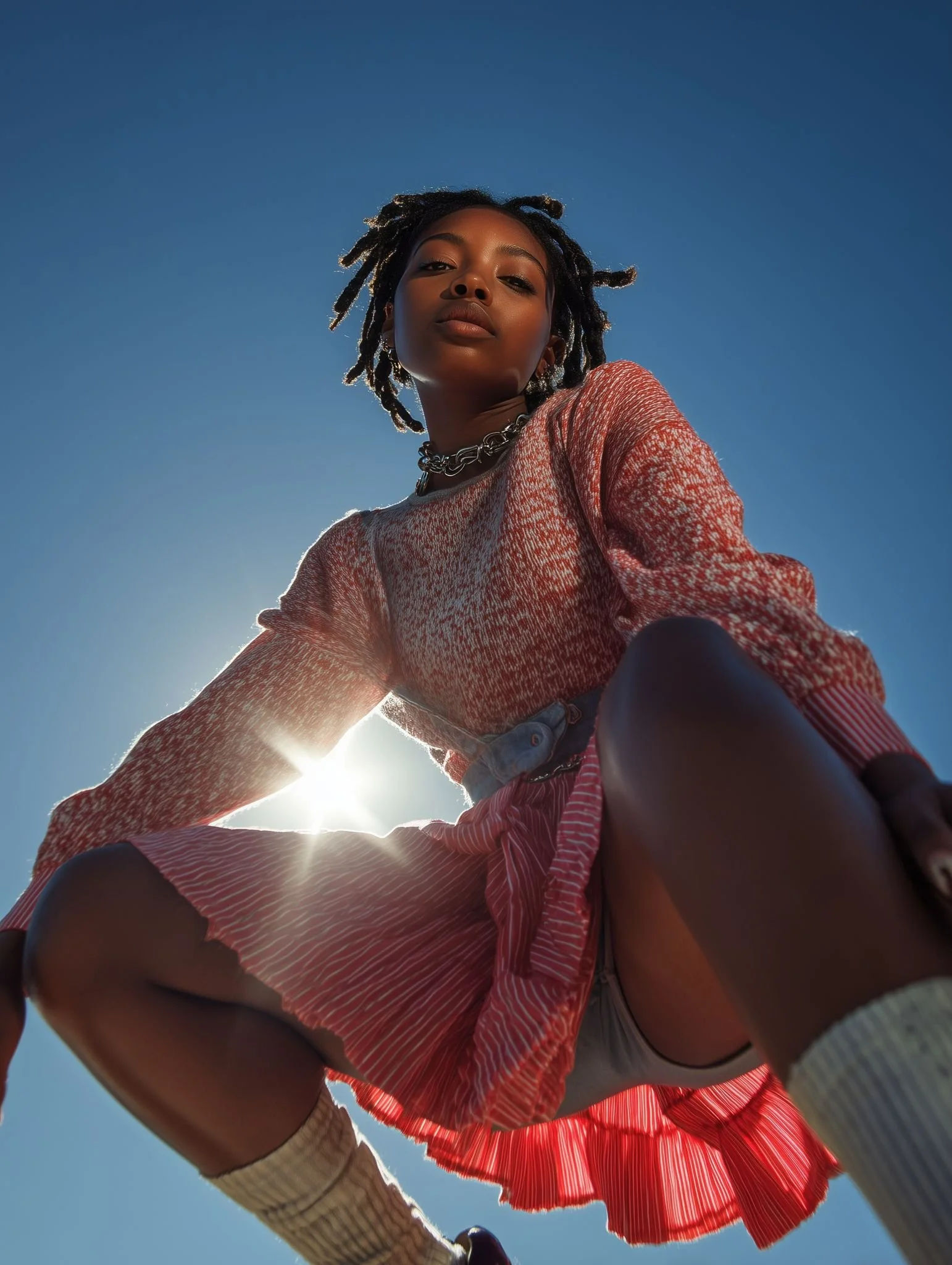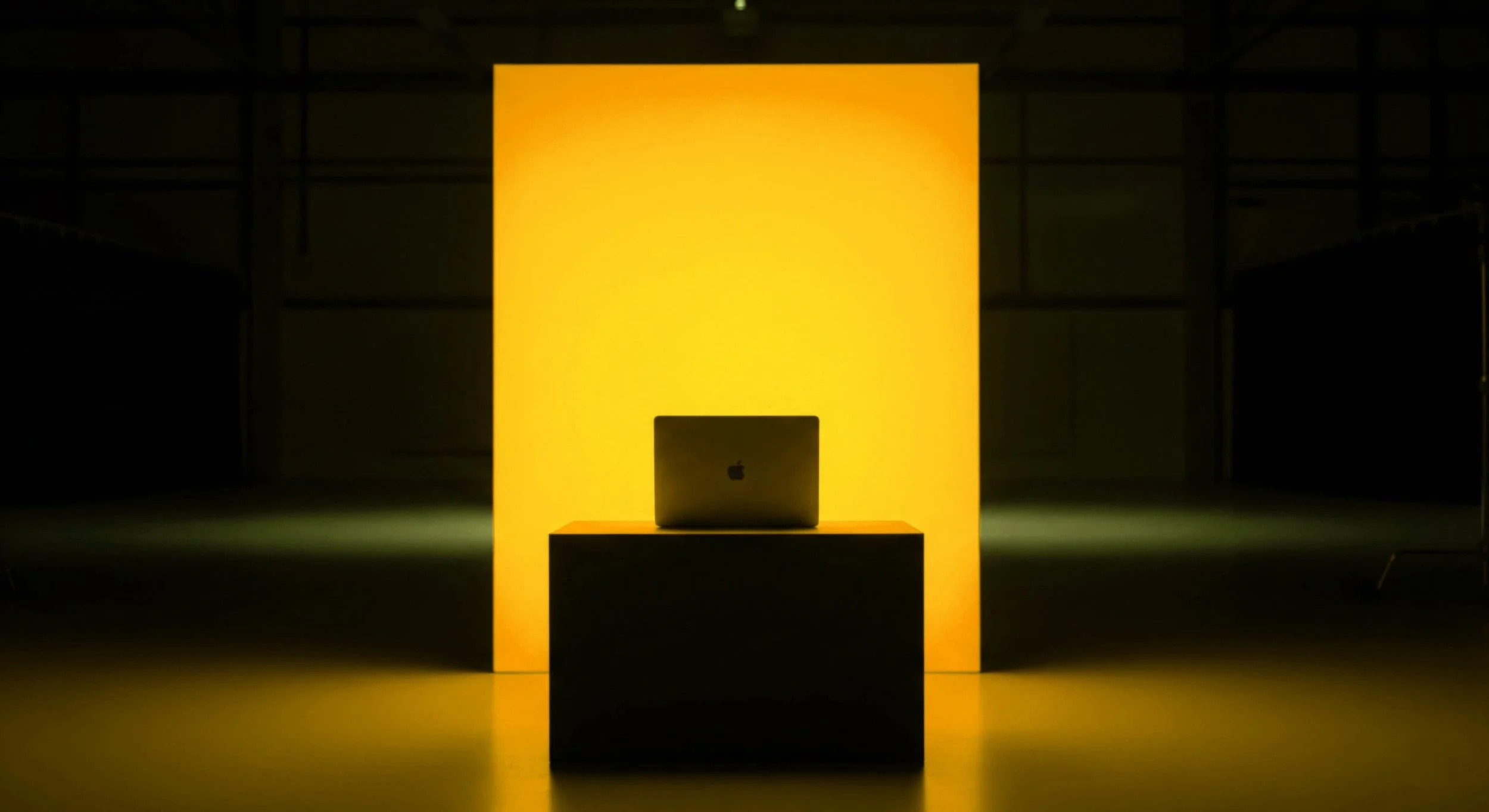
From Director to Curator.
A New Framework for the Age of AI in Video Production.
Beyond the Hype
The conversation surrounding generative AI in the creative industries is trapped in a cycle of spectacle. We are fixated on what the latest models can do, but the more urgent and strategic conversation is not about the tool itself, but about how we must re-architect our creative processes, team structures, and mindsets to harness its power. The industry is asking, "Can AI do this?" when it should be asking, "How do we organise ourselves to create value with this new capability?"
Attempting to force generative AI into legacy, linear production workflows is a recipe for mediocrity and strategic failure. The technology is not a more efficient version of an old tool; it is a new paradigm that demands a new operational framework. To thrive, we must move beyond the hype and adopt a structured approach. This article provides that structure, drawing on lessons from past technological disruptions to frame a new strategic framework for the age of AI.
This framework is organised around five core pillars:
The Mindset Shift, from director to curator.
The Reality Spectrum, defining a newly stratified market.
The New Skillset, elevating the system thinker over the tool operator.
The Strategic Goal, reframing AI as a tool for engineering emotion.
The Complexity Advantage, arguing that video's technical difficulty creates a unique opportunity.
Together, these pillars offer a comprehensive guide for navigating the most significant creative transformation of our time.

Historical Precedent - Lessons in Adaptation
To understand the future, we must first examine the past. The advertising and video production industries have been shaped by a series of technological disruptions, each of which forced a fundamental rethinking of roles, workflows, and the very definition of creative value. These historical shifts provide a powerful lens through which to analyse the current AI revolution, revealing recurring patterns of adaptation that can guide our strategy today.
The Agency Transformed: From the Assembly Line to the Creative Team
Before television, advertising followed a linear assembly line. A copywriter, as the primary conceptual force, would write the ad's text and pass it to an art director for layout. This siloed process was suited for the text-driven medium of print.
The arrival of television, a medium combining sight, sound, and motion, rendered this model obsolete. In the 1960s, Bill Bernbach of Doyle Dane Bernbach (DDB) catalysed a revolution by pairing art directors and copywriters into collaborative "creative teams." This fundamentally shifted the workflow from sequential execution to parallel ideation. The "big idea" now emerged from the dynamic interplay between visual and verbal thinking, a structure so effective it became the industry standard for a half-century.
This history provides a powerful precedent for the organisational change required by generative AI. Treating AI as an executor for a "perfect" prompt mirrors the old copy-first model and fails to leverage the technology's iterative, collaborative nature. The Bernbach model is the true analogue: a dynamic, real-time dialogue between a human creative and the AI system, where the final concept is discovered through iteration. This process requires a synthesis of human taste and machine-generated variation.
Simultaneously, the economic realities of broadcast television gave us the 30-second spot. This format was standardised not because it was creatively optimal, but because it was most profitable for networks. This is a crucial reminder that industry standards are often shaped by commercial pressures - a pattern already repeating in the AI era.
The Digital Deluge and the Demand for Volume
The transition from broadcast to the internet and social media was the next great disruption. This era shifted the focus from crafting a few high-stakes assets for a mass audience to producing a high volume of content tailored for fragmented platforms. The singular 30-second TV spot was replaced by a constant stream of banner ads, social posts, and pre-roll videos.
This change created new priorities and roles. The need for data-driven targeting and real-time optimisation gave rise to specialists like social media managers and data analysts. The strategic goal was no longer just a memorable message, but delivering personalised and relevant content at scale.
The digital era conditioned the industry for the scale and personalisation that generative AI now offers. For two decades, the appetite for high-volume, tailored creative has been growing, but production remained a labour-intensive bottleneck. AI is not inventing a new demand; it provides a revolutionary supply-side solution to a demand that has been building since the dawn of the internet. This explains why AI's first commercial applications have focused on high-volume ad generation, solving one of the industry's most chronic operational headaches.
The Production Pipeline Reimagined: From the Splice to the Timeline
The video production industry's shift from linear editing on film to non-linear editing (NLE) on computers provides a powerful metaphor. Linear editing was a painstaking, destructive process where every cut was permanent, discouraging experimentation. NLEs, catalysed by systems like Avid/1, digitised footage and made editing non-destructive. Editors were suddenly free to experiment with countless variations, elevating their role from technical operator to creative partner.
Generative AI offers a similar creative freedom. Just as NLEs allowed editors to experiment without fear of destroying the original footage, AI allows creatives to generate countless conceptual variations without the prohibitive upfront cost of traditional production. This reduces the risk associated with failure to near zero, transforming the creative process from high-stakes execution to low-stakes exploration.
The Rise of the Technical Artist: How CGI Blurred the Lines
The final and most direct historical precedent comes from the rise of computer-generated imagery (CGI) and visual effects (VFX). From its experimental beginnings in films like Tron (1982) and Westworld (1973) to its role as a central pillar of modern blockbusters like Jurassic Park (1993) and Avatar (2009), the integration of CGI has fundamentally reshaped filmmaking.
As the software became more powerful, a gap emerged between the artists who envisioned shots and the engineers who built the tools.
This gap was filled by the Technical Director, a hybrid role combining artistic taste with deep technical proficiency. TDs act as a crucial bridge, translating artistic intent ("we need a more chaotic explosion") into technical execution (writing a new particle simulation script). The role was born of necessity, as the technology was too complex for a traditional artist to leverage alone.
The VFX TD is the most important historical analogue for the essential new creative role in the AI era. As generative models become more complex and opaque, a similar professional is required to translate a director's aesthetic intent into the "language" of the AI system - a task involving not just prompts but also model architectures and fine-tuning. The TD's emergence proves that when a technology's complexity outpaces traditional creative skills, a specialised, hybrid role inevitably arises to bridge the gap.

The Five Pillars for the Future of Video
Drawing upon these historical lessons, it is possible to construct a strategic framework for navigating the AI-driven future of video production. This framework is not a technical manual for using AI tools, but a strategic guide for reorienting mindset, talent, market positioning, and creative goals. It consists of five interdependent pillars.
Pillar 1: The Mindset Shift - From Director to Curator
The most fundamental shift required is in the creative mindset itself. The traditional model of creative direction has been one of top-down control, where a director conceives a singular vision and a team is tasked with executing it precisely. In this "director" model, deviation is a flaw and control is paramount.
Generative AI renders this model obsolete. To work effectively with AI is to collaborate with a "chaotic partner" - a system that is probabilistic, not deterministic. It excels at generating unexpected variations but resists precise, top-down control; forcing it into a purely executional role ignores its greatest strength.
The new, more effective model is that of the "curator." In this framework, the primary methodology shifts from originating the perfect idea to guiding the AI, evaluating its vast outputs, and selecting the most promising results. The process becomes a dialogue where the leader provides strategic direction, the AI generates a spectrum of possibilities, and the leader then refines and selects from those options.
In the curatorial model, the most valuable human skills are no longer manual dexterity but taste, strategic discernment, and the ability to recognise unexpected brilliance. This shift elevates the leader. When the volume of potential creative output becomes nearly infinite, the bottleneck moves from production to selection. The value is no longer in the craft of making, but in the wisdom of choosing. To unlock this model at scale, a new, essential role is emerging to bridge the gap between traditional creative direction and the complex, technical world of AI.
Pillar 2: The Reality Spectrum - A Three-Tiered Market
The impact of generative AI on video production is not monolithic. The market is rapidly stratifying into a three-tiered spectrum, each with distinct workflows, cost structures, talent requirements, and strategic applications. Agencies, brands, and production houses must consciously and strategically decide where on this spectrum they intend to compete.
Tier 1: Automation
This tier is defined by the use of AI for high-volume, template-driven, and personalised content, primarily for performance marketing, social media, and e-commerce. The strategic goal is efficiency and scale. Companies in this space, such as Pencil, offer platforms that can generate hundreds or thousands of ad variations from a simple product URL or text prompt, automating tasks like resizing, copy generation, and localisation. A prime example of this tier in action is Carvana's campaign that created over 1.3 million unique, personalised videos for individual customers, recapping their specific car-buying journey - a feat of scale impossible through traditional means.
Tier 2: The Hype Trap
This tier represents a cautionary tale, populated by early AI efforts that have been criticised for a lack of strategy, poor execution, or using the technology for hype rather than substance. A notable example is the controversy surrounding robotics company Figure AI's partnership with BMW. The founder's claims of a "fleet" of humanoid robots performing "end-to-end operations" were reportedly contradicted by BMW, which stated it was only testing a single robot on a single task during off-hours. This highlights the risk of over-promising on AI's capabilities for marketing purposes. Another example is Coca-Cola's AI-generated holiday campaign, which produced abstract and bizarre visuals that many felt lacked the brand's characteristic warmth and emotional connection, demonstrating a failure of strategic curation. This tier is where technology is adopted without a clear framework, leading to results that are either ineffective or reputationally damaging.
Tier 3: High-End Integration
At the apex of the market, AI is not a replacement for human talent but a powerful, specialised tool integrated into larger, expert-led production pipelines. Here, the goal is not automation but augmentation. A real-world example is a recent project for the United Nations. After delivering the campaign, the client requested a new 10-second introductory sequence to provide additional context. With reshoots being logistically impossible, we proposed an AI-enhanced VFX workflow. We extended a sequence from the original footage, using generative AI to create dozens of iterations of new backgrounds, objects, and people. Crucially, these AI-generated assets were not the final product but raw elements, which were then meticulously composited by artists in a traditional VFX pipeline. The result was an intro that seamlessly matched the existing film, solving a problem that would have otherwise been impossible to solve. The single 10-second sequence required six full days of dedicated work, underscoring that Tier 3 is about expert augmentation, not simple automation.
This hybrid model is becoming standard, with major VFX houses using AI to handle painstaking tasks like rotoscoping (as seen in The Mandalorian) or generating complex digital assets, freeing up artists for higher-value creative work. This stratification of the market is a fundamental restructuring. The business model, talent, and technology needed for Tier 1 efficiency are fundamentally different from those required for Tier 3 integration. Leaders must make a conscious choice about where they will compete, as attempting to be a "jack-of-all-trades" will likely lead to being a master of none.
Pillar 3: The New Skillset - From Software Operator to System Thinker
The Rise of the Integrator
This shift from software operator to system thinker creates a critical gap for a new, pivotal role to emerge. This individual acts as the essential bridge between a Creative Director's vision, the capabilities of AI, and the realities of traditional production. This integrator must possess a hybrid skillset, combining a deep understanding of conventional pipelines with the ability to navigate iterative, generative technology.
While the exact title is still taking shape, it revolves around a fusion of artistic, technical, and production expertise.
This skillset marks a definitive shift in where value lies. The most valuable creative professional of the next decade will not be the best operator, but the best problem-solver and system-builder. This is not an evolution of an existing role but the creation of a new one, and companies that wish to lead in this new era must actively seek and cultivate this hybrid talent.
The competencies for these roles include:
Advanced Prompt Engineering: The discipline of crafting nuanced, context-rich prompts in an iterative dialogue with the AI.
Understanding Model Architectures: A functional knowledge of different AI models (e.g., Diffusion models for photorealism, Generative Adversarial Networks for stylised visuals) to select the right tool for a specific creative task.
API Integration: The ability to use programming interfaces to chain multiple specialised AI services into a single, custom workflow.
Each AI model has a fundamental design or "blueprint", which determines its creative strengths, weaknesses, and personality. A creative leader doesn't need to know the complex engineering behind it, but they absolutely need to know when to use each one. This knowledge is about choosing the right tool to bring a specific vision to life.
| Feature | Google Veo 3 | Runway Gen-4 | Hailou-02 |
|---|---|---|---|
| Max Resolution | Up to 4K | Up to 1080p | 1080p |
| Max Clip Length | 8 seconds | 5-10 seconds | 6-10 seconds |
| Key Strengths | High fidelity, contextual understanding, and integrated sound generation (dialogue, SFX, music). | Excellent character and object consistency using reference images. The Aleph model allows for conversational, in-context video editing. | Advanced physics simulation. Strong character consistency and "Director" mode for cinematic camera controls. |
| Key Limitations | Short clip length, prompt misunderstanding, strict content filters, and inconsistent character models. | Steep learning curve. The Aleph model is limited to processing short clips. Users report chaotic motion and long queue times. | No native audio generation. Short clip length and struggles with complex scenes. Primary interface is in Chinese. |
Pillar 4: The Strategic Goal - Engineering "The Feeling"
The most successful brands understand a fundamental truth: in a battle between logic and emotion, emotion always wins. Campaigns built on emotional connection consistently outperform those based on rational, feature-based messaging because emotionally connected customers are more loyal and valuable. The ultimate goal of high-level branding is not to inform the consumer, but to make them feel something.
Historically, surrealism has been a powerful tool for achieving this. Inspired by the logic-free world of dreams, surrealist advertising uses bizarre and unexpected imagery to bypass the rational mind. Iconic campaigns for brands like Guinness ("Dreamer") and Cadbury ("Gorilla") didn't try to argue with the viewer; they created an indelible mood, a feeling that became inextricably linked with the brand.
This brings us to the native aesthetic of today's generative AI video, whose output is often described as uncanny, dreamlike, or strange. While many in the industry view these qualities as technical flaws to be overcome in the pursuit of photorealism, this is a strategic error. These inherent aesthetic qualities are not a bug; they are a powerful creative feature. The "weirdness" of AI is perfectly suited to engineering a specific feeling, creating an immediate emotional impact that cuts through the clutter.
Therefore, the most sophisticated strategic application of AI video today is not to fight its nature but to embrace it. The goal should shift from "making AI video look real" to "using AI video to create a real feeling." This reframes the technology's current limitations as a unique stylistic advantage, aligning a cutting-edge tool with a timeless principle of effective branding.
Pillar 5: The Complexity Advantage - Video as the Final Frontier
While AI for text and images is relatively mature, video remains the final frontier. Leading models as of mid-2025 show incredible progress but are far from simple "push-button" solutions. Issues like short clip durations, character inconsistency, and visual artefacts mean that generating professional-grade AI video is a complex, multi-stage workflow requiring expert intervention.
This immense technical difficulty, however, is not a weakness but a strategic opportunity. It creates a formidable "strategic moat" - a barrier to entry that rewards serious, committed players and provides a durable first-mover advantage. The organisations that invest now in mastering these complex workflows will build an insurmountable lead in expertise and refined pipelines by the time the technology becomes easy for everyone.
The return on this early investment is twofold: it offers immediate creative differentiation and unlocks targeted production efficiencies. The true strategic advantage lies not in pursuing 100% AI production, but in creating sophisticated, AI-enhanced workflows.
Traditional production remains the backbone for high-stakes, emotionally complex storytelling, as AI currently lacks the necessary creative intuition - a capability it may never truly possess. In this hybrid model, AI serves as a powerful tool for specific, intensive tasks - like rotoscoping or using generative technology to create complex 3D textures and unique digital props - freeing up human artists to focus on higher-level creative decisions like narrative, performance, and final curation. This is where the real value is unlocked, underscoring the need for leaders fluent in both traditional and generative techniques.

A Call for Strategic Partnership
For most large agencies and brands, the most capital-efficient path is not to build a massive in-house AI R&D team. The optimal strategy is to form deep, symbiotic partnerships with the specialised, agile Production and VFX studios that operate on the bleeding edge. In this model, the large agency brings brand strategy and client access, while the specialist studio brings deep technical mastery, creating a whole that is far greater than the sum of its parts.
Ultimately, the companies that win in this new era will not be those that simply adopt AI the fastest, but those that adopt it the most strategically. The challenge is not a technological race but a race for organisational and strategic adaptation. The future belongs to the discerning curators, the holistic system thinkers, and the strategic partners who choose to build lasting capability over chasing fleeting trends.
Let’s work together
Navigating this new landscape requires not just a new framework, but new forms of collaboration. We are actively seeking partnerships with forward-thinking agencies and brands who are ready to move beyond the hype and build a real, sustainable competitive advantage. By combining our deep expertise in AI-enhanced, as well as traditional production and post-production workflows, with your brand vision and market knowledge, we can co-create the future of video production. If you are ready to explore these new possibilities and help define the next era of creative excellence, we invite you to connect with us.
https://www.linkedin.com/in/czaicki/
https://www.linkedin.com/in/icimelifsenol/













